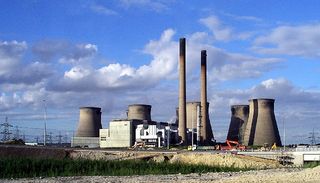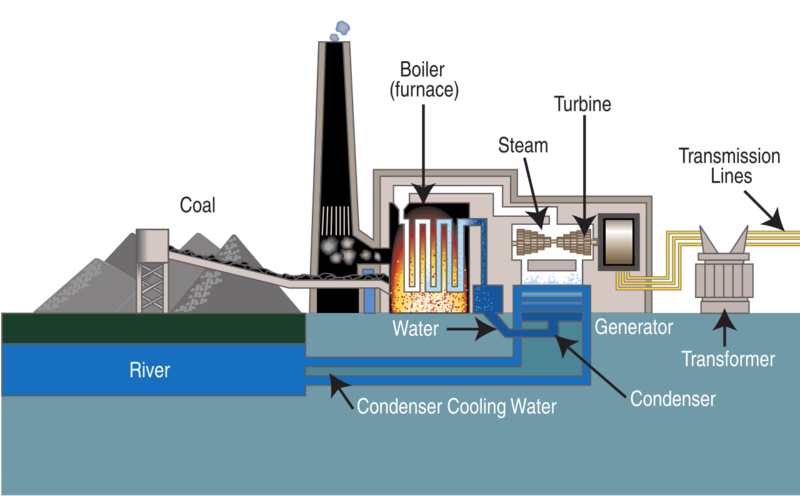Coal fired power plant

Coal fired power plants are a type of power plant that make use of the combustion of coal in order to generate electricity. Their use provides around 40% of the world's electricity and they are primarily used in developing countries.[2] Countries such as South Africa use coal for 94% of their electricity and China and India use coal for 70-75% of their electricity needs, however the amount of coal China uses dwarfs most other countries (see the data visualization below).[3] The use of coal provides access to electricity to those who previously didn't have it, which helps to increase quality of life and reduce poverty in those regions, however it produces large quantities of different pollutants which reduces air quality and contributes to climate change.
Burning huge amounts of coal
Coal plants require enormous amounts of coal. Shockingly: a 1000 MWe coal plant uses 9000 tonnes of coal per day, equivalent to an entire train load (90 cars with 100 tonnes in each!).[4] The amount of coal used during a full year would then require 365 trains, and if each is 3 km long then a single train carrying all of this coal would need to be about 1100 km long; about the same distance as driving from Calgary AB to Victoria BC. If this train were to pass by your house at 40 kilometers per hour, it would take more than a day to pass!
The conversion of this coal to the end goal of electricity is a multi-faceted process:[6]
- The coal must be unloaded from the train. Traditional ways of doing this require the use of cranes picking up the coal from the cars, however newer plants have the floor underneath the train tracks drop away, allowing the coal to be dropped into underground containment. Doing so doesn't even require the train to stop moving![7] For a video of this please see here. Many coal plants are mine mouth which means the plant was put where the coal mine is, so the coal doesn't need to be transported by train.
- Once unloaded, the coal is then pulverized into a fine powder by a large grinder. This ensures nearly complete burning of the coal in order to maximize the heat given off and to minimize pollutants.
- The pulverized coal is then input to a boiler, where combustion occurs and the coal provides heat to the power plant. This heat is transferred to pipes containing high pressured water, which boils to steam.
- The steam then travels through a turbine, causing it to rotate extremely fast which in turn spins a generator, producing electricity. The electricity can then be input to the electrical grid for use by society.
Coal fired power plants follow the Rankine cycle in order to complete this process. Since they require plenty of water to be circulated in this cycle, coal power plants need to be located near a body of water. The process of coal fired plants can be seen below in Figure 3.

Environmental Impacts
Coal power plants have many associated environmental impacts on the local ecosystem.
Air pollution
The burning of coal releases many pollutants - oxides of nitrogen (NOx) and sulfur (SOx) - and particulate matter. They also emit greenhouse gases, such as carbon dioxide (CO2) and methane (CH4), which are known to contribute to global warming and climate change. To help stunt the emission of these, power plants require technology to reduce the output of these harmful molecules.[9]
Water Use/Pollution
Large quantities of water are often needed to remove impurities from coal,[10] in the process is known as coal washing. For instance, in China, around one-fifth of the water used in the coal industry is used for this process.[11] This process helps reduce air pollution, as it eliminates around 50% of the ash content in the coal. This results in less sulfur dioxide (SOx) being produced, along with less carbon dioxide (CO2) due to higher thermal efficiencies.[9]
When power plants remove water from the environment, fish and other aquatic life can be affected, along with animals relying on these sources.[10] Pollutants also build up in the water that power plants use, so if this water is discharged back into the environment it can potentially harm wildlife there.[10]
The discharge of water from the power plants and coal washing requires monitoring and regulation. Visit the US Environmental Protection Agency (EPA) for more information on this.
World Electricity Generation: Coal
The map below shows which primary energy different countries get the energy to generate their electricity from. Coal is seen in grey. Click on the region to zoom into a group of countries, then click on the country to see where its electricity comes from. Some notable countries include China, India, USA, Russia, Canada, and France.
References
- ↑ Wikimedia Commons [Online], Available: https://upload.wikimedia.org/wikipedia/commons/7/76/Ferrybridge_%27C%27_Power_Station_-_geograph.org.uk_-_35089.jpg
- ↑ World Coal Association. (June 10 2015). Coal and Electricity [Online]. Available: http://www.worldcoal.org/coal/uses-of-coal/coal-electricity/
- ↑ Data Source: IEA (2014), "World energy balances", IEA World Energy Statistics and Balances (database). DOI: http://dx.doi.org.ezproxy.lib.ucalgary.ca/10.1787/data-00512-en (Accessed February 2015)
- ↑ R. A. Hinrichs and M. Kleinbach, "Electricity: Circuits + Superconductors," in Energy: Its Use and the Environment, 4th ed. Toronto, Ont. Canada: Thomson Brooks/Cole, 2006, ch.10, sec.A, pp.320
- ↑ Callum Black on Geograph. (June 23 2015). Coal train [Online], Available: http://www.geograph.org.uk/photo/450234
- ↑ R. A. Hinrichs and M. Kleinbach, "Electromagnetism and the Generation of Electricity," in Energy: Its Use and the Environment, 4th ed. Toronto, Ont. Canada: Thomson Brooks/Cole, 2006, ch.11, sec.D, pp.376-377
- ↑ Discovery via user: Largest Dams, Coal Fired Power Plant - England [Online Video], Available: https://www.youtube.com/watch?v=rEJKiUYjW1E
- ↑ Wikimedia Commons [Online]. Available: http://upload.wikimedia.org/wikipedia/commons/thumb/4/4a/Coal_fired_power_plant_diagram.svg/1280px-Coal_fired_power_plant_diagram.svg.png
- ↑ 9.0 9.1 World Coal Association. (June 10 2015). Coal Use & the Environment [Online]. Available: http://www.worldcoal.org/coal-the-environment/coal-use-the-environment/
- ↑ 10.0 10.1 10.2 EPA Clean Energy. (June 10 2015). Coal [Online]. Available: http://www.epa.gov/cleanenergy/energy-and-you/affect/coal.html
- ↑ IEA. (June 22 2015). Why most coal avoids a bath [Online], Available: http://www.iea.org/ieaenergy/issue6/why-most-coal-avoids-a-bath.html


